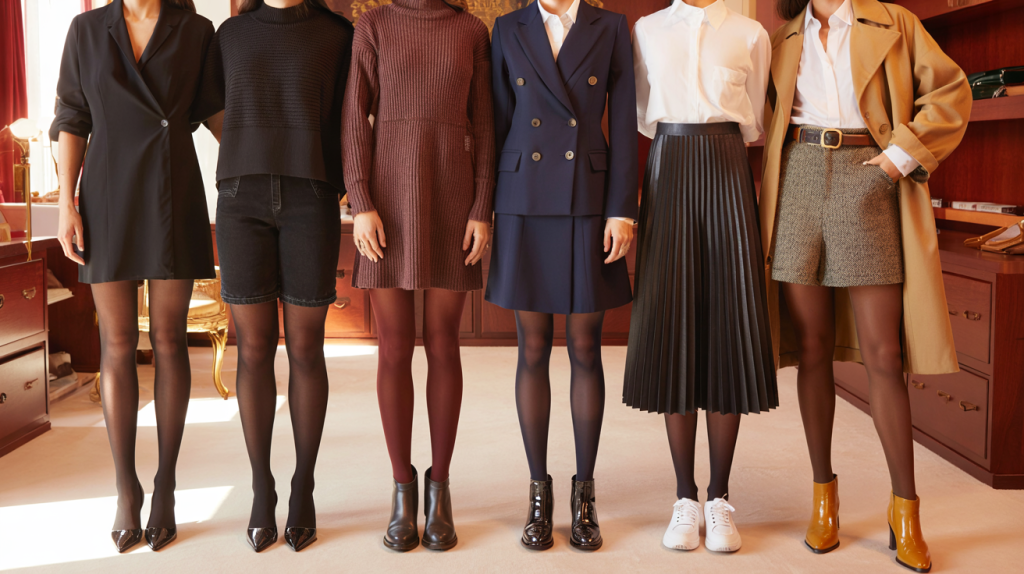Clicked to solve the tights puzzle fast. Here is the short answer that saves a morning meltdown: match denier to season and formality, pick a color that anchors the outfit, then choose finish and details that work with your shoes and hemline.
For everyday work looks, sheer to semi opaque tights keep lines clean. For cold days or casual outfits, opaque tights sharpen proportions and add warmth. Black lengthens the leg, nude blends, navy and brown soften, burgundy or charcoal support rich autumn palettes. Simple, and it works.
Denier decoded: warmth, coverage and polish
Denier tells you thickness and coverage. According to Encyclopaedia Britannica, denier measures the mass in grams of 9,000 meters of yarn, so a higher number means a thicker, more opaque fabric.
Think in ranges. Around 5 to 20 denier is sheer and ultra light for dressy days or indoor events. Between 30 and 60 delivers semi opaque balance that flatters office looks. From 70 to 120 gives true opaque coverage for cool weather and structured styling.
Texture matters. Matte feels modern and photo friendly. A subtle sheen lifts evening outfits and satin shoes. Control top helps under fitted skirts. Reinforced toe protects in closed shoes, invisible toe suits sandals and peep toes.
Color that flatters the whole outfit
Color changes perception quickly. Research by Satyendra Singh published in 2006 in the journal Management Decision found that 62 to 90 percent of initial product judgments relate to color, which explains why the right tight shade can make a look click.
Black streamlines lines on dark outfits and grounds bold prints. Navy softens black shoes or a navy suit. Brown and chocolate warm camel, tweed and tan boots. Charcoal integrates with grey tailoring without the stark contrast of black.
Nude depends on undertone, not just depth. Aim for a near match that disappears under daylight, not just indoor lighting. Slightly cooler or warmer tints blend better than a perfect depth with the wrong undertone.
Outfit pairings that always work
When time is tight, use these quick matches. They respect silhouette, context and shoes.
- Little black dress with pumps : 20 to 30 denier sheer black or graphite, matte finish for a clean line.
- Knit dress and ankle boots : 60 to 80 denier opaque black or burgundy, cotton touch for warmth.
- Navy suit and loafers : 30 to 50 denier navy or smoke, invisible toe if shoes show more skin.
- Pleated midi skirt with sneakers : 40 denier semi opaque black or charcoal to anchor volume.
- Beige trench and tweed skirt : 30 to 50 denier brown, works with tan leather and gold hardware.
- Party mini and slingbacks : 15 to 20 denier sheer black with subtle sheen, invisible toe.
- Printed dress : pick tight color from the darkest shade in the print so the eye reads it as one.
Patterns deserve one hero at a time. If the dress already carries checks or florals, keep tights plain. When the outfit is simple, micro dots or herringbone add texture without stealing focus.
Mistakes to avoid and the easy fixes
Wrong denier breaks proportions. If a skirt is floaty and light, ultra opaque tights can feel heavy. Switch to semi opaque to balance movement and coverage.
Shiny tights under office lighting read glossy on camera and in glass reflections. Choose matte for meetings and open plan spaces. Save sheen for low light venues and evening photos.
Toe and shoe must agree. Reinforced toes show in slingbacks and peep toes, even when you think they will not. Invisible toes remove that line. If sandals are on the menu, look for sandal toes and a tighter knit at the arch.
Static cling wrinkles silhouettes. A quick spritz of fabric spray or a touch of hand cream on palms then over the tights calms static before leaving the house.
Size affects comfort and look. Between sizes, go up for a smoother waist and cleaner leg. Most labels publish a height and weight grid, follow it. Waist rolling means the body needs more rise or a comfort waistband.
A note that explains why tights became a wardrobe constant. On May 15, 1940, nylon stockings first went on sale in the United States and roughly 4 million pairs were sold that day according to Smithsonian Magazine. Materials evolved, finishes multiplied, yet the core rules above still hold.
Build a simple selector and stop hesitating. Start with context and weather. Choose denier that fits both warmth and formality. Lock color to the outfit’s base and shoes. Decide on finish, toe and any control feature. Ten seconds, definitly doable before coffee.
